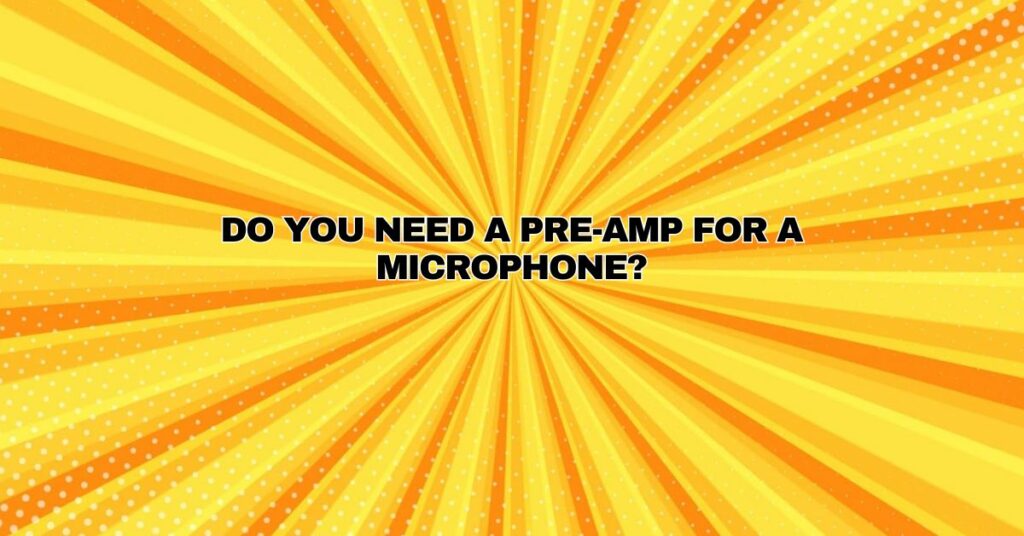The realm of audio recording and production is a multifaceted landscape with a myriad of gear and equipment, each serving a distinct role in the quest for pristine sound. When it comes to microphones, the question often arises: do you need a preamp? In this comprehensive article, we will explore the significance of preamplifiers in the context of microphones, their functions, types, and when they are necessary to elevate the quality of your audio recordings.
Understanding the Basics
To comprehend the role of preamps in microphone setups, it’s crucial to first understand the fundamentals:
Microphones: Microphones are transducers that convert sound waves into electrical signals. They consist of a diaphragm that vibrates in response to sound, generating a weak audio signal.
Preamps (Preamplifiers): Preamplifiers are electronic devices designed to amplify low-level audio signals. They serve the essential function of boosting the microphone’s weak electrical output to a standard line-level signal suitable for recording or further processing.
Line-Level Signal: A line-level signal is the standard electrical signal level used in audio equipment. It is typically stronger than the weak signal generated by a microphone.
The Importance of Preamps
Preamps play a pivotal role in the audio chain for several reasons:
- Signal Boost: Microphones produce weak electrical signals that need amplification to reach an optimal recording level. Preamps provide this essential amplification.
- Noise Control: Quality preamps are equipped with low noise floors, ensuring that the amplified signal maintains a high signal-to-noise ratio. This results in cleaner recordings.
- Tonality and Coloration: Some preamps are prized for their tonal characteristics and the subtle coloration they impart to the audio signal. This can enhance the sonic qualities of a recording, contributing to the uniqueness of the sound.
Types of Preamps
There are two primary categories of preamps commonly used in microphone setups:
- External Preamps: These standalone preamps are separate devices that can be connected between the microphone and recording equipment. They are prized for their sound quality and versatility, offering various gain settings, tonal options, and other features.
- Built-in Preamps: Many audio interfaces, mixers, and digital recorders come equipped with built-in preamps. While these preamps may not always match the quality and features of high-end external preamps, they are often sufficient for many recording scenarios.
When Do You Need a Preamp for a Microphone?
The need for a separate preamp for your microphone largely depends on the following factors:
- Microphone Type: Some microphones, like dynamic microphones, produce stronger output signals and may not require external preamps in all cases. On the other hand, condenser microphones, particularly low-output models, often benefit from external preamps.
- Sound Quality Goals: If you prioritize exceptional audio quality and wish to shape the sound with tonal characteristics, an external preamp is a valuable addition to your setup.
- Recording Environment: In professional studios and high-end recording scenarios, external preamps are often used to achieve the best possible sound quality and flexibility.
- Budget Constraints: If budget constraints are a concern, built-in preamps on your audio interface can be a reasonable starting point. You can later invest in an external preamp as your budget and requirements grow.
- Specific Applications: Certain applications, such as studio vocal recording, acoustic instrument miking, and professional audio production, may benefit from the enhanced control and features offered by external preamps.
Preamp Alternatives
In situations where a separate external preamp may not be necessary, some alternatives can help you achieve suitable microphone amplification:
- Built-in Preamps: As mentioned earlier, many audio interfaces, mixers, and recorders include built-in preamps, offering a convenient and cost-effective solution.
- Digital Audio Workstations (DAWs): DAW software often provides digital gain control and processing options that can adequately boost your microphone signal.
- In-Line Gain Boosters: In-line devices like “cloud lifters” or “in-line preamps” can be used with dynamic and ribbon microphones to provide additional gain without the need for a full-fledged external preamp.
Conclusion
The necessity for a preamp in your microphone setup ultimately depends on your specific requirements and goals. While external preamps offer the advantages of exceptional sound quality, tonal control, and low noise, they may not be essential in every scenario. Built-in preamps on audio interfaces and digital audio workstations can provide adequate amplification for many applications, especially when budget constraints are a concern. As you delve into the world of audio recording and production, carefully consider your microphone, recording environment, and sound quality objectives to determine whether a preamp is the missing link in your pursuit of audio excellence.


